10 Unexpected Elements You Need for an Organic Modern Dining Room to Elevate Your Space
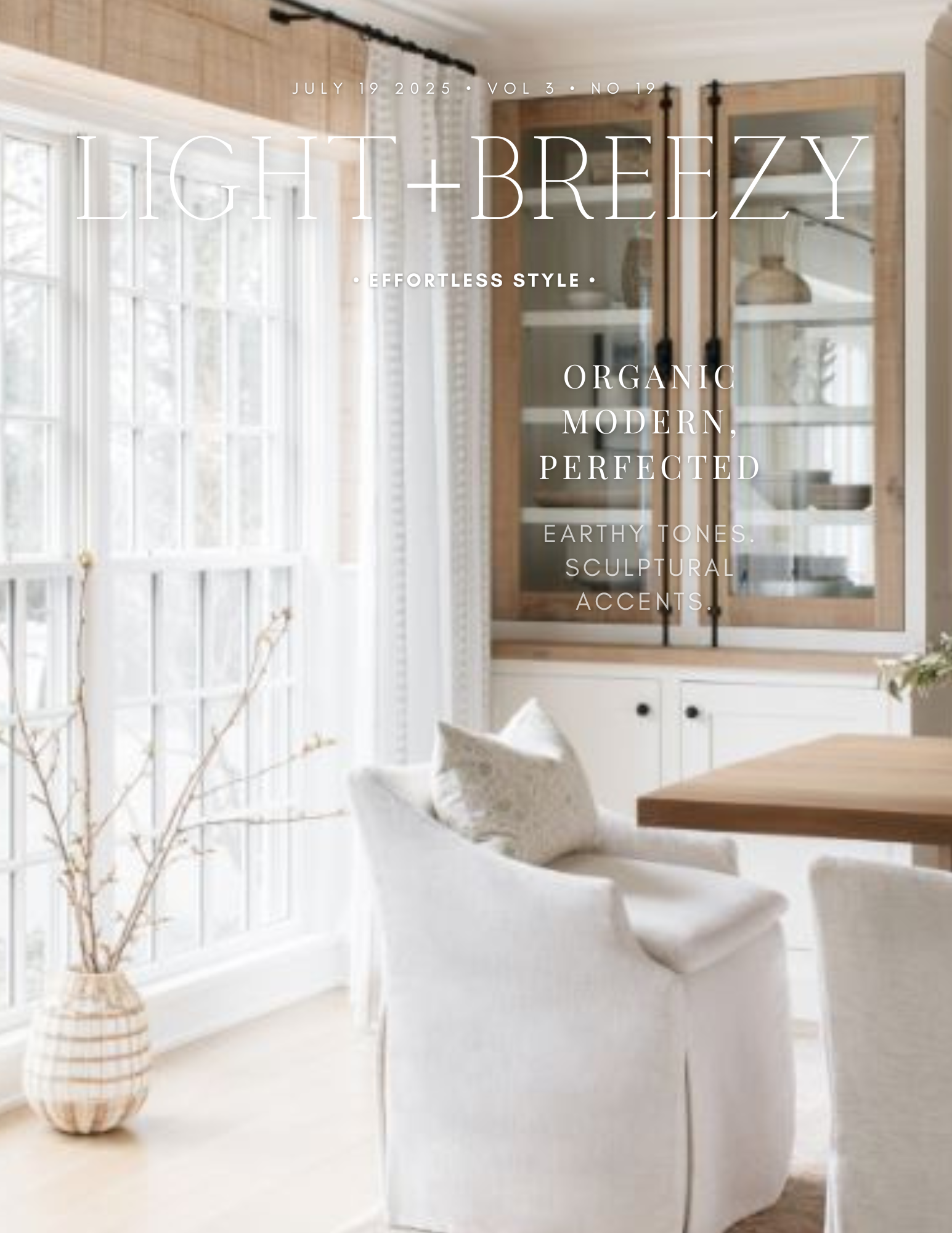
Want to refresh your dining room in a way that feels natural and current? The organic modern look mixes clean lines with materials that bring warmth and comfort.
This style’s easy to love—simple, but still inviting and inspiring. With the right mix, you can add personality and depth while keeping things relaxed and cozy.
You’ll discover amazing and unexpected materials that can help turn your dining room into a welcoming space with modern charm.
Recycled glass tabletop accents
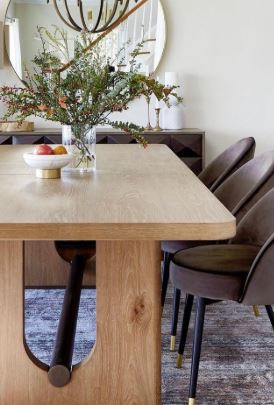
Recycled glass gives your dining room a fresh, modern feel. These pieces usually come in soft greens, blues, or clear tones that brighten up your table.
You can use recycled glass for vases, jars, candle holders, or little bowls. Their uneven shapes and subtle color differences make things feel relaxed and organic, especially next to natural wood or stone.
Try a glass tray or a mosaic centerpiece on your dining table. Recycled glass reflects light, adding a gentle shimmer and making the space feel brighter—without being flashy.
Look for serving dishes or platters made from reclaimed glass. They’re practical, and honestly, they show you care about the environment.
Handmade or artisan options can add even more personality. Recycled glass works well with greenery, dried flowers, or a simple linen runner.
Design Tip: Group two or three recycled glass objects in different shapes and colors at your table’s center for an easy, eye-catching display.
Driftwood centerpiece bowls

Driftwood centerpiece bowls bring nature right to your table. Each piece has a unique shape, with soft edges and weathered textures that add interest without feeling too polished.
Driftwood’s a favorite for organic modern spaces because it’s natural and simple. It doesn’t overwhelm your table, so things never look crowded. Instead, you get a calming, coastal vibe that fits with other natural materials.
Use a driftwood bowl for fruit, bread, or decorative stones. It works just as well empty, serving as a quiet focal point. The rough finish pairs nicely with smooth ceramics and woven fabrics for contrast.
No two driftwood bowls are alike, which keeps your dining room from feeling generic. Driftwood’s neutral color lets it blend with almost any palette.
Design Tip: Place your driftwood bowl in the center and keep it simple—just one or two natural elements inside, like fresh fruit or a few dried flowers, really highlight the wood’s texture.
Raw ceramic serving dishes

Raw ceramic serving dishes bring a grounded, natural vibe to your dining room. Their unglazed or lightly glazed surfaces show off soft, earthy textures that fit perfectly with an organic modern style.
These dishes often have simple, handmade shapes. Each piece is a bit unique, so your table setting feels more personal and less like a catalog. The natural tones—white, gray, sand—blend easily with other tableware and linens.
Raw ceramics are durable and practical for everyday use. They handle hot or cold foods and look great with fresh fruit, salads, or bread. The matte finish keeps things soft, not shiny.
Pair raw ceramic dishes with wood or woven placemats to tie together other natural elements. They work for both casual and more formal gatherings.
Design Tip: Place raw ceramic serving dishes on a simple linen runner to highlight their handcrafted look and keep the space cozy and inviting.
Woven rattan pendant lights
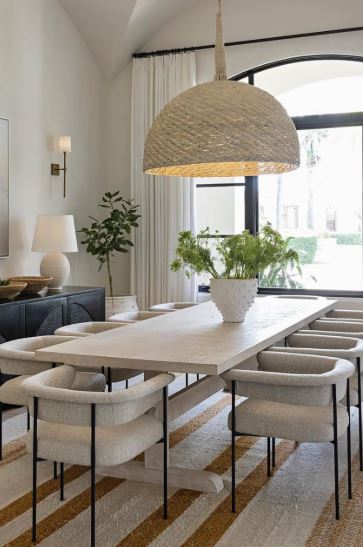
Woven rattan pendant lights bring a warm, natural touch above your dining table. The fibers add gentle texture and interest without feeling heavy.
You’ll notice the light is soft and a little dappled, creating a cozy, relaxed atmosphere. Perfect for dinners or casual get-togethers. Rattan pendants fit with so many styles, from modern to rustic.
Rattan is eco-friendly and comes from renewable sources. Choosing rattan lights adds nature without breaking the bank, and they’re easy to install since they’re lightweight.
You’ll find rattan pendants in all kinds of shapes, sizes, and even colors. Some are simple and round, others bold or unique, so you can really pick what fits your vibe.
Design Tip: Hang two or three smaller rattan pendants at different heights above your table for a stylish focal point.
Natural cork placemats
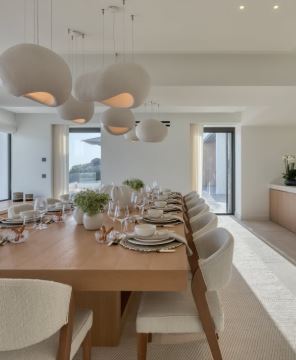
Natural cork placemats are a smart pick for an organic modern dining room. Cork comes from the bark of cork trees—a renewable, eco-friendly source. The bark grows back after harvest, so you can feel good about using it.
These placemats have a soft texture and warm, earthy tones that add a natural element without going full rustic. Cork also protects your table from hot dishes and scratches.
Cork is lightweight but tough, so you can use these placemats every day. Cleaning’s easy—just wipe with a damp cloth. They come in plenty of designs and shapes, so you can actually have fun picking what fits your space.
Since cork is biodegradable, it’s a smart choice if you’re trying to cut waste at home. The unique grain and texture make each placemat a little different, which is a nice touch.
Design Tip: Pair cork placemats with linen napkins and simple stoneware plates for a balanced organic modern look.
Bamboo woven dining chairs

Dining Chairs made from bamboo fibers bring an organic, natural look to your space. Bamboo grows fast and makes strong, lightweight furniture with a pattern that stands out.
When woven, bamboo creates flexible but sturdy seating. These chairs are comfy and have a relaxed, casual vibe. The open weave lets light flow through, so your dining room feels airy and open.
Bamboo’s eco-friendly, too. Choosing it for your chairs means you’re using a renewable material. Its natural tones play well with most wood tables and neutral palettes.
You can mix bamboo chairs with other natural elements like wood, stone, or linen. They’re versatile—modern or rustic, they fit right in. The texture brings depth and warmth to your dining area.
You don’t need a full set—just two bamboo chairs at the ends of your table can make a statement. Mixing materials keeps things interesting.
Design Tip: Add colorful seat cushions to your bamboo chairs for softness and a pop of color. It highlights the woven pattern and makes the room feel more inviting.
Stoneware salt and pepper shakers

Stoneware salt and pepper shakers might be small, but they make a big difference. Their smooth, glazed finish and solid shape add a cozy, earthy vibe to any meal. Stoneware’s fired at high temps, so it’s tough enough for busy families.
You’ll find these shakers in all sorts of colors, patterns, and shapes. Some look classic, others show off handmade details. It’s easy to match them to your tableware or use them as a special accent.
Stoneware is dishwasher safe and doesn’t hold onto flavors or odors. Your salt and pepper stay fresh, and each set’s a little different, which adds character.
Choosing stoneware helps your table feel more natural and relaxed. Even with a modern style, the material brings warmth and texture that fits the organic modern trend.
Design Tip: Put your stoneware shakers in the center of the table with a wood or linen tray to draw the eye and add an inviting touch.
Hand-carved olive wood salad server set
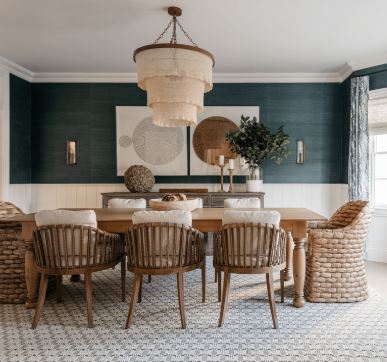
Hand-carved olive wood salad servers add warmth and natural character to any table. Their unique wood grain and smooth finish make every set feel special.
Artisans often make these servers from olive trees that no longer produce fruit. So, you get a beautiful, eco-friendly piece and give old wood a new life.
Olive wood’s strong and durable. When you hold a set, you’ll notice how lightweight yet sturdy they feel. The rounded handles are comfy, whether you’re hosting a dinner party or just making a quick salad.
They’re food-safe, finished with natural oils, and easy to clean. Olive wood doesn’t react with food, so flavors stay fresh.
Since these servers are usually handmade, no two sets are exactly the same. Some even have extra details like bone handles or etched designs—little works of art, honestly.
Display them on open shelves or pair with ceramic or glass salad bowls for a laid-back, organic feel. These touches help your dining room feel welcoming and lived-in.
Design Tip: Keep your olive wood salad servers visible in a utensil jar or on a tray so they double as decor and a handy tool.
Table runners in jute fibers
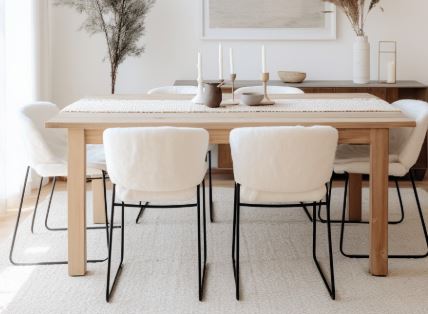
Jute fiber table runners add a natural touch to your dining room. Jute comes straight from plants and has a down-to-earth, rustic vibe.
The woven texture feels inviting and relaxed. It almost begs you to sit down and enjoy a meal.
Most jute runners use natural fibers, so they’re sturdy and eco-friendly. If you want an earthy look without synthetic stuff, they’re a solid choice.
Jute usually sticks to soft, neutral colors. That makes it easy to match with all kinds of dishes and tableware.
You won’t have to stress about clashing decor—jute’s pretty adaptable. Use a jute runner daily for family meals, or save it for special dinners.
Let it stand out as the main feature, or layer it with placemats for extra texture. Jute lasts a long time if you treat it right.
Spilled something? Blot the spot fast and let it dry flat. Roll your runner instead of folding to keep it looking fresh.
Design Tip: Run a jute runner down your table’s center and add some ceramic dishes or simple glass vases. This brings out that natural style and keeps things feeling easygoing.
Organic cotton dining room napkins with hand-stitched edges
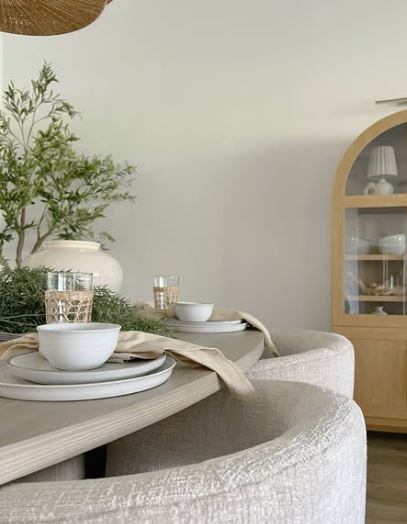
Organic cotton napkins make your dining table feel fresh and natural. They’re made without harsh chemicals or pesticides, so you’re making a healthier pick.
The cotton feels soft, which is a nice bonus when you’re eating. Look for napkins with hand-stitched edges.
Those little stitches add a handmade, personal touch. Plus, they help keep the napkin edges from fraying over time.
Organic cotton napkins come in all sorts of colors and patterns. Whites and earth tones work with most dining spaces, but hey, grab a bold color if it makes you happy.
Sets usually come with four napkins, which works for everyday meals or small get-togethers. Hand-stitched napkins tend to last longer because someone actually cared about making them.
Most are easy to wash and reuse, so you’ll use fewer disposables. This fits right into an organic modern style that values reusable, earth-friendly things.
Design Tip: Layer your organic cotton napkins with hand-stitched edges over simple, neutral plates for a cozy feel. Fold them neat or just knot them for a laid-back, inviting look.
shopping sources
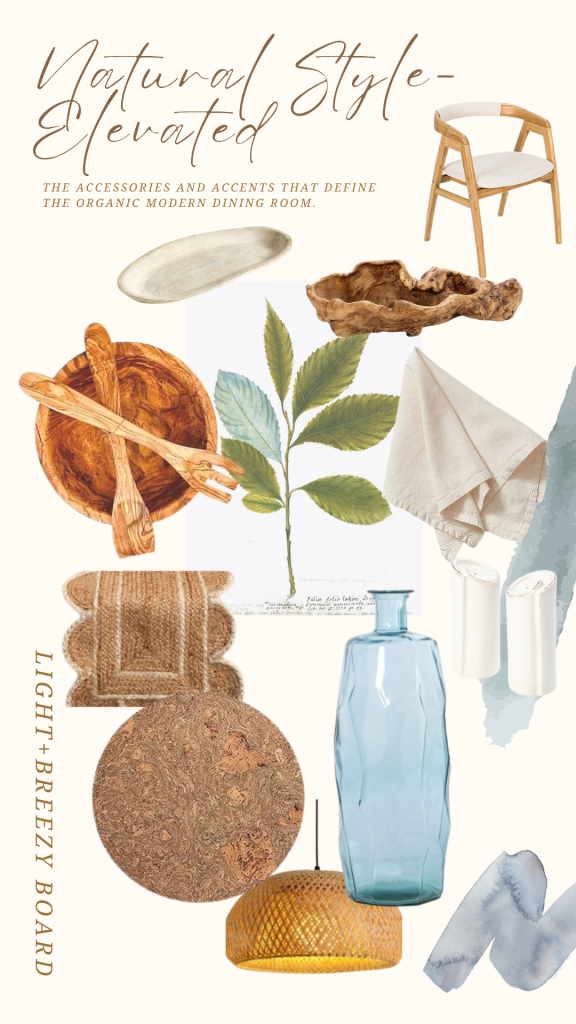
links:
Raw Ceramic | Driftwood | Bamboo Chair
Salad Set | Print | Organic Napkins
Jute Runner | Recycled Glass | Shakers
Cork Placemat | Rattan Pendant
Benefits of Integrating Unexpected Materials
Mixing unexpected materials into your organic modern dining room shakes up the style and brings in practical perks. Unique pieces can totally change the vibe and make each spot feel special.
Elevating Visual Interest
When you use unusual materials, your dining room won’t feel flat or predictable. Reclaimed wood, marble scraps, or woven seagrass catch the eye and spark conversation.
Details like these add personality and make your space feel custom, not cookie-cutter. Try a stone-topped sideboard or hang copper pendant lights above your table.
Swap out plain chairs for ones with leather straps or a rattan frame. Shapes and patterns you don’t usually see in dining rooms create layers in the design.
This makes your dining area memorable, even if the rest of your place stays simple.
Encouraging Sustainable Choices
Bringing in unexpected materials often nudges you toward more eco-friendly options. Many surprising finishes come from natural, recycled, or reclaimed stuff.
For example, tabletops made from old barn wood or lights from upcycled metal help cut down on waste. Look for products labeled non-toxic, responsibly sourced, or Fair Trade when you can.
By thinking about where these things come from, you support better manufacturing. That’s good for your home, the planet, and the folks who made your decor.
Just a few swaps can really matter. Trade out plastic or synthetic items for cork, bamboo, or natural linen.
Your dining area stays safer and healthier for your family.
Enhancing Textural Contrast
Unexpected materials bring in new textures that make your dining room feel lively. Pair sleek glass with rough wood, or set a soft wool runner on cool concrete.
Mixing surfaces gives the room depth. Try layering a bumpy cotton tablecloth under smooth ceramic dishes, or pop a hammered metal vase in the center.
When you mix these contrasts, the space feels lived-in, not stiff. Pick a few rich textures—maybe velvet chair cushions or a woven grass wall hanging—to pull it all together.
Your dining room looks thoughtfully designed but still feels relaxed for meals or guests.
Tips for Blending Unconventional Materials in Organic Modern Design
Organic modern dining rooms look their best when you mix authentic textures with clean, modern details. Getting the mix right means paying attention to balance, pairing, and color.
Balancing Natural and Man-Made Elements
Start by using both natural and man-made materials. Maybe pair a raw wooden table with metal lights, or put a sleek glass vase on a chunk of recycled concrete.
Let natural textures lead and add man-made accents for contrast. For example:
| Natural Material | Man-Made Material | Suggested Pairing |
|---|---|---|
| Oak wood | Polished steel | Table with steel legs |
| Rattan | Concrete | Woven chairs around concrete bar |
| Stone | Glass | Stone bowl with glass candle |
Don’t let one side take over. Natural surfaces usually keep the room warm, while sleek finishes add depth.
Layering Materials for Cohesion
Layering matters when you’re working with lots of materials. Stack, overlap, or group objects so the textures feel intentional, not random.
Pick a few main materials—like wood, linen, and recycled metal. Then sprinkle in accents of stone, ceramic, or woven fibers for more depth.
Don’t crowd every inch with something unique. Use repetition to tie things together, like a matching set of ceramic plates or woven placemats.
Mix shiny, soft, and rough materials in small doses so the room feels designed, not chaotic. Keep scale in mind, too.
A big wooden table works with smaller glass pendants or slim metal candlesticks. That way, each material stands out without making things feel cluttered.
Maintaining a Minimalist Color Palette in an Organic Modern Dining Room
Stick to a minimalist color palette so your unique textures really shine. Shades like soft white, beige, taupe, and warm brown pull everything together and make the mix of materials feel intentional.
Matte and natural finishes? They’re just easier on the eyes, honestly. The room feels calmer that way.
If you’re itching for a pop of color, muted earth tones—think deep green or clay red—work, but keep those accents on the quieter side.
You can use a simple chart to pick your palette:
| Base Color | Accent Color | Secondary Color |
|---|---|---|
| White | Sand/beige | Olive green |
| Taupe | Charcoal | Terracotta/clay |
| Warm brown | Black | Soft rust orange |
Let most things stay neutral. Pick one or two elements to stand out—don’t overthink it.
